This summer, we appear to have two predominant species of cudweeds growing on the property. Both plants are members of the Asteraceae (sunflower) family. At present, the genera for these species appears to be in flux, but currently the accepted genus for both of these cudweeds is Pseudognaphalium.
Pseudognaphalium stramineum (syn. Gnaphalium stramineum)
This species is an annual to biennial herb, native to western North America. Common names for Pseudognaphalium stramineum include Chilean cudweed (this species was previously known as Gnaphalium chilensis), everlasting cudweed, small flowered cudweed, annual cudweed, and cotton batting plant.
The word gnaphalium is derived from the Greek gnaphalon, meaning “a lock of wool”, and stramineum means “straw-colored”.
Pseudognaphalium stramineum blooms between May to October. Flowers are white, appearing yellow, to straw-colored, in bud.
Leaves are narrowly lanceolate, ranging from 2-8 cm in length.
This plant is renowned for growing in disturbed areas, and has a preference for moist sandy soils. Heaviest concentrations of this plant are presently in the orchard, which has been heavily disturbed between tree planting, and deer-fence installation the past year.
A hot poultice of leaves and stems from this plant, applied to the body, was used by the Kawaiisu as an analgesic. The Navajo and Ramah peoples used this plant as an emetic, and the Pomo would apply a poultice of boiled plants to reduce facial swelling.
This plant also had value in hunting. The Pomo and Kashaya would use the cottony material from the flower tops as a stuffing to line their deer antler head disguises [1].
Pseudognaphalium californicum (syn. Gnaphalium californicum)
Pseudognaphalium californicum is known commonly as ladies’ tobacco, California rabbit tobacco, California cudweed, and California everlasting.
This species is also native to the west coast of North America from Washington to Baja California. This is an annual or biennial plant with a branching stem reaching 20 to 80 cm in height. Stem branches have lance-shaped leaves 2 to 20 cm in length.
The inflorescence is a cluster of flower heads, each enveloped in an involucre of rows of white phyllaries.
There doesn’t appear to be much of this second species growing here, and where it is found is up-slope of the orchard, in a relatively undisturbed area, in association with Lotus scoparius, and Diplacus aurantiacus.
The American Painted Lady Butterfly (Vanessa virginiensis) uses this plant as food for its larvae. A number of these butterflies have been sighted in the orchard area recently. Alas, none close enough to my lens to photograph them.
Although some consider cudweeds to simply be ‘weeds’, some native plant nurseries do stock this particular species as it is quite attractive, and a valuable larval food source.
An infusion of Pseudognaphalium californicum was used by the Costanoans for treating stomach pain, and as a cold remedy. [1]
——————
[1] Daniel E. Moerman’s Native American Ethnobotanical Database



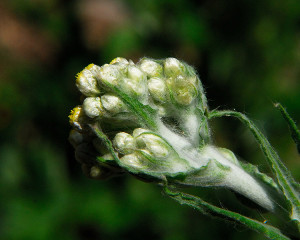
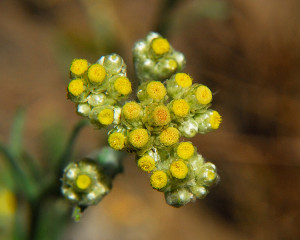
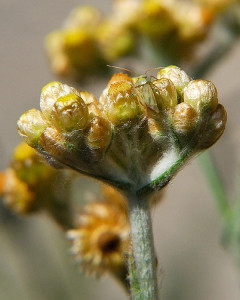
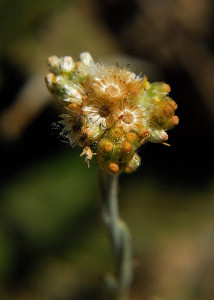


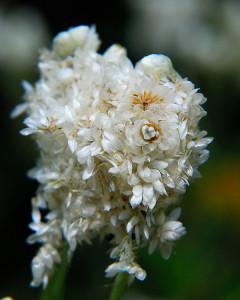







Clare these are wonderful images of native flowers I have never heard of. At first I assumed they were so called because ruminants chew them! You’ve garnered so much information too – you must be quite an expert on wildflowers now, not to mention their medicinal uses. I like the use for deer antler head disguises
Laura
Even your weeds are beautiful! I have many weeds flourishing right now, and I know the names of few of them. No doubt the Native Americans who lived in my area knew all about them and had good uses for many of them!
I’m going to guess that I have pulled many of these out of my yard, as it appears the hill behind my house is infested with them. I should probably take a picture of what’s back there, as I’m sure you could identify it in a second.
From my reading yesterday, they favor disturbed soils, and if the soils aren’t disturbed for an extended period of time, their numbers actually gradually decline. Maybe you can stop pulling them? 😛
Really good reading about these often over looked plants. Just so you know American Painted Lady that name is no longer used. it is Now Just American Lady not to be confused with the Painted Lady which uses thistles for a host plant. See my page at http://www.rlephoto.com/brushfoots/lady_american01.htm
Thanks. Darn taxonomists. It challenging enough keeping up with all the taxonomic shifts with plants and fungi. At least the genus and species is the same. I can live with changes in common names.
Thank you for giving me the name to this plant. I’ve been wondering about it for quite some time.
I have a soft spot for these plants. They grow in cracks in the sidewalk, and in places that nobody loves.
I wish you had more of the second one growing there, Clare. It’s got an ethereal beauty; doesn’t it? And then you tell me it supports the Painted Ladies who I love so much… maybe what’s on your property will grow as you get rid of more invasives and it gets space?
This afternoon, I saw a hummingbird feasting on some tall flowering things I’d thought of as merely “weeds” — and this post makes me remember my surprise. The florets are so tiny, and not that bright (pale lavender), and the hummer flew away immediately thereafter, not bothering to visit a nearby plant I’d bought specifically to attract him. 😉
I love the californicum species, it really is beautiful. Apparently, these plants are first on scene in disturbed sites, but over time, as the vegetation re-establishes in a site, they slowly regress. I presume they don’t compete well with other vegetation, so I’m not sure how easy they’ll be to encourage here.
Good Morning Clare
I prefer the 2nd cudweed – it has such pretty a flower. I hope you’ll be able to encourage more of that in the orchard.
I was just thinking about those people who used to pick the cottony bits from the first one to line their head disguises – it must have taken them ever so long to collect any amount of that – and I wonder what they then used to keep it in place inside the masks.:)
I thought about that yesterday. How many of these plants do they need to take ‘batting’ from? Native Americans did ‘manage’ the land. California at least used to have more and larger wildfires historically, ‘disturbing’ the land. I wonder if these plants were significantly more abundant then, than they are now? I have no idea what they used to hold it in place in their antler disguises 😛
Thanks for sharing these photos and info. In the East we have Sweet Everlasting (P. obtusifolium), not quite as showy as #2. I can get these to germinate well in pots, but have a hard time after transplanting them to have them mature. Either the wrong soil or they just don’t like to be moved. Sweet everlasting has a curry-like aroma when crushed or disturbed, do your plants have that trait?
I haven’t noticed a particular aroma, but I also haven’t tried crushing them. Now I’m intrigued. Our plants here favor sandy soils, and actually seem to grow with no supplemental irrigation. They’re fading now, as we’ve not had any significant rainfall since early June.
Your photography certainly made these weeds look beautiful! Though they may be but a common weed that springs up in disturbed locales, it sounds like they have a very important job in supplying food for butterfly larvae. : )
Clare,
thank you for this information. I have this plant growing in my butterfly garden and noticed that the hummingbirds gather the “cotton” so I left it for them. I did not know that the American Lady used it. I am so happy that I did not pull them up!